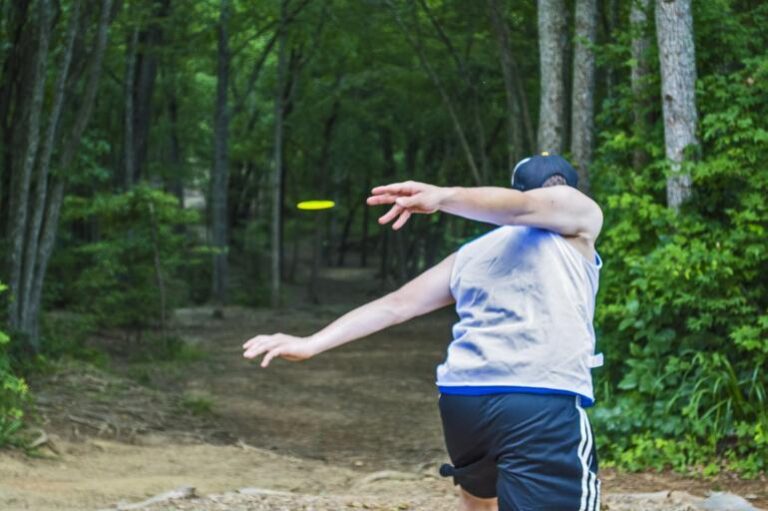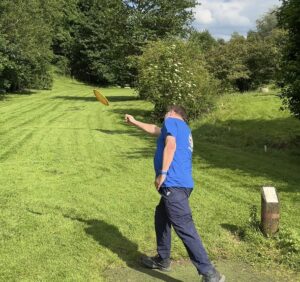Optimizing Your Disc Golf Backhand Drive for Success

Perfecting a powerful and accurate disc golf backhand drive is the holy grail for any disc golfer. This fundamental throw forms the foundation of your game, shaping your ability to navigate courses, attack obstacles, and land those coveted birdies. Whether you’re a seasoned competitor or a weekend warrior just starting out, refining your backhand drive is an investment that will yield dividends on every course you play. This comprehensive guide will equip you with the knowledge and techniques to break down the mechanics of the perfect backhand drive, transforming you into a more confident and effective disc golfer.
As a seasoned disc golfer, I can confidently say the backhand drive is the foundation of my game. It’s the throw I rely on for the vast majority of my shots, offering a blend of distance and accuracy that keeps me competitive on the course. While I’ve got a good grip on throws like the roller and the hammer for specific situations, the backhand drive remains my go-to for navigating fairways and putting myself in birdie position.
However, getting really good at the backhand drive takes dedication and practice. It wasn’t always my most comfortable or consistent throw. In the beginning, I struggled with wobble, inconsistency, and a lack of power. But through focused practice and guidance from experienced players, I was able to refine my technique and unlock the true potential of this versatile throw.
This guide is designed to help you do the same. Whether you’re a complete beginner or looking to refine your existing backhand drive, we’ll break down the essential steps and techniques into a clear, step-by-step process. By the end, you’ll be equipped with the knowledge and tools to throw powerful, accurate backhands that elevate your disc golf game.
Step-by-Step Guide to a Perfect Backhand Drive:
Now that you understand the importance of the backhand drive, let’s delve into the mechanics of executing a perfect throw.
Here’s a step-by-step breakdown that dissects each stage of the throwing motion:
- Grip
A secure and comfortable grip is the foundation for a controlled and powerful throw. There are two main grip styles commonly used in backhand throws:
Power Grip: This grip provides maximum power and control. Wrap your thumb around the rim of the disc, with your first two fingers stacked on top and your remaining fingers curled comfortably underneath the disc. Check out the Professional Disc Golf Association website for a visual guide on the power grip.
Fan Grip: This grip offers more flexibility and can be helpful for players with smaller hands. Spread your fingers out slightly like a fan across the flight plate of the disc, with your thumb resting comfortably on the rim underneath.
The best grip for you depends on your hand size, throwing style, and personal preference. Experiment with both options and see which one feels most comfortable and allows for consistent control of the disc. - Stance and Posture
Your body position plays a crucial role in generating power and maintaining balance during the throw. Here’s the ideal stance for a backhand drive: Stand with your feet shoulder-width apart, with your front foot slightly angled towards the target. You can find helpful visuals and explanations on proper stance on websites like dgCourseReview.com.
Maintain a slight bend in your knees and keep your core engaged for stability.
Your upper body should be slightly tilted away from the target, with your throwing arm hanging relaxed behind you.
Proper posture ensures a balanced and efficient throwing platform, allowing you to transfer power from your core to the disc effectively. - The Reachback
The reachback initiates the throwing motion and builds momentum for a powerful release. Here’s how to execute a proper reachback: Extend your throwing arm straight back behind you, reaching as far as comfortably possible without straining your shoulder.
The disc should be held flat in your hand, parallel to the ground.
Engage your core muscles as you extend your arm to initiate the rotational sequence for the throw.
A controlled reachback builds momentum while maintaining control of the disc. Avoid reaching back too far, which can lead to loss of balance and accuracy. - Hip Rotation and Weight Transfer
Hips are the engine of the backhand drive. Here’s how to maximize their role in generating power: As you initiate the throw, rotate your hips explosively towards the target. Imagine your belly button pulling towards the target as your hips rotate.
Simultaneously, transfer your weight from your back leg to your front leg as you rotate your hips. This weight transfer adds significant power to your throw.
Focusing on powerful hip rotation and weight transfer is crucial for unlocking the true distance potential of your backhand drive. - The Pull-Through and Power Pocket
The pull-through motion transfers energy from your core and hips to the disc. Here’s how to achieve a smooth and powerful pull-through:
As your hips rotate, pull the disc towards your chest, creating a “power pocket” near your core. The disc should be angled slightly upwards at this point.
Maintain a tight grip on the disc throughout the pull-through motion.
The power pocket momentarily stores the energy generated from your hip rotation before releasing it into the disc during the throw. Imagine the disc being pulled into a slingshot formed by your arm and core. - Snap and Release
The disc release is where accuracy and control culminate. Here’s how to achieve a clean and efficient release:
As your hips rotate through and your front foot plants firmly, snap your wrist flicking the disc outwards towards the target on the desired flight path. Imagine snapping a towel with your wrist for a visual cue.
Maintain a firm grip on the disc until the moment of release, then allow your fingers to extend naturally as the disc leaves your hand.
A clean release with proper wrist snap ensures the disc exits your hand on a straight line, minimizing wobble and maximizing accuracy. - Follow-Through
A proper follow-through maintains balance and indicates a smooth and complete throwing motion. Here’s what your body should be doing at the end of the throw:
Your entire body should be facing the target after the release, with your weight fully transferred onto your front leg.
Your throwing arm should be extended outwards following the line of the throw, with your hand pointing towards the target.
Maintain a balanced posture for a moment after releasing the disc to ensure proper weight transfer and stability.
A good follow-through demonstrates a complete transfer of energy from your body to the disc. By following these steps, you’ll develop a more efficient and powerful throwing motion.
The Techniques and Strategies
Now that you have a solid understanding of the step-by-step mechanics of a backhand drive, let’s delve deeper into some key techniques and strategies that will elevate your throws:
Improving Your Grip and Control
While maintaining a secure grip is essential, gripping the rim too tightly can hinder your control and release. Focus on a firm yet comfortable grip that allows for a smooth release with proper wrist snap.
As discussed earlier, the two main backhand grip styles are:
- Power Grip: Offers maximum power and control, ideal for experienced players.
- Fan Grip: Provides more flexibility and can be helpful for beginners or players with smaller hands.
Experiment with both grips and choose the one that feels most comfortable and allows for consistent control of the disc.
Enhancing Consistency and Accuracy
Developing consistent backhand throws requires focused practice and attention to detail. Here are some tips:
- Practice regularly: Repetition is key to ingraining proper muscle memory and achieving consistent form.
- Focus on form over power: Understanding the mechanics before focusing on brute strength will lead to more consistent throws in the long run.
- Record yourself: Filming yourself throwing and analyzing the footage can help identify areas for improvement.
- Seek feedback: Ask experienced players or disc golf instructors to observe your throws and offer constructive criticism.
Here are some aspects to focus on to improve your backhand swing:
- Maintain a smooth and controlled swing: Avoid jerky or rushed motions.
- Engage your core: A strong core provides stability and power transfer.
- Maintain proper posture: Keep your shoulders level and avoid hunching over.
- Practice drills: Utilize drills that target specific aspects of your swing, such as reachback drills or follow-through drills.
Getting Better Backhand Shots
Here are some strategies for achieving better backhand shots:
- Disc selection: Choose the right disc for the situation. Consider factors like stability, weight, and desired flight path.
- Mindset: Approach throws with confidence and focus on executing proper form.
- Visualization: Visualize a successful throw before you execute it.
Improving Backhand Distance
Here are some techniques to increase backhand distance:
- Proper weight transfer: Ensure smooth and complete weight transfer from your back leg to your front leg during the throw.
- Engage your core and hips: Generate power through core rotation and hip rotation, not just arm strength.
- Snap your wrist effectively: A powerful wrist snap at the release point adds significant distance to your throws.
- Disc selection: Choose discs with a higher speed rating for achieving maximum distance. However, prioritize control over excessive speed if you’re still developing your form.
Troubleshooting Common Backhand Drive Issues
A wobbly backhand can be caused by several factors, including an inconsistent grip, improper weight transfer, and lack of snap on release. Refer back to the previous sections on grip, weight transfer, and wrist snap to diagnose and fix the culprit behind your wobbly throws.
Exploring Advanced Techniques
How to Throw a Backhand Roller
The backhand roller shot, a low-trajectory wizard that skips and slides across the ground, might seem like a magic trick at first. But fear not, for with a little practice, you too can get really good at this course-conquering throw.
There are two main types of roller shots: the ground roller and the hyzer flip roller. The ground roller stays low to the ground throughout its flight, making it ideal for navigating tight spaces or skipping under obstacles. The hyzer flip roller starts with a hyzer release (tilted disc at an angle) but flips up during its flight, offering a combination of distance and a low-ceiling approach.
Nose Angles and Their Impact
Ever wonder why your disc sometimes dives unexpectedly or veers off course? The culprit might be your nose angle. This refers to the angle of the disc relative to the ground at release. A flat nose angle will result in a straight flight path, while a hyzer angle (tilted disc down) will cause the disc to fade left (for right-handed throwers) and vice versa for anhyzer (tilted disc up). Becoming proficient at nose angle manipulation allows you to shape your throws for various situations, like curving around obstacles or achieving a controlled descent near the basket.
Perfecting Your Backhand Drive Mechanics
The Importance of Balance and Posture
Imagine a skyscraper – it needs a strong foundation to reach towering heights. The same principle applies to your backhand drive. Proper balance and posture are the bedrock of a powerful and consistent throw. A slight bend in the knees with your core engaged creates a stable base, while keeping your shoulders level prevents unnecessary tension.
Want to take your balance to the next level? Try single-leg throws – these force you to engage your core muscles and improve overall stability. Wall drills are another great option – stand a few feet from a wall and practice your throwing motion without following through. This helps isolate your upper body mechanics and ensure you’re initiating the throw with your core, not just your arm.
Footwork and Leg Drive Techniques
Your legs are the engine that propels the disc forward. Proper footwork and leg drive are crucial for generating power and transferring it efficiently to the disc. The basic principle involves a slight pivot on the ball of your back foot as you rotate your hips, transferring your weight to your front leg as you release the disc.
There are various footwork drills you can incorporate into your practice routine. One popular option is the “shuffle step drill,” where you shuffle side-to-side, mimicking the weight transfer motion used in the backhand throw. Another helpful drill is the “standing X-step,” where you practice the footwork sequence without actually throwing the disc. This allows you to focus on smooth weight transfer and proper hip rotation.
Fine-Tuning Your Grip and Release
Developing a Strong Wrist Snap for Increased Distance
Imagine a slingshot – the faster you snap the rubber bands, the farther the projectile flies. The same concept applies to your disc golf backhand drive. A powerful wrist snap at the moment of release translates to increased disc velocity and ultimately, greater distance.
Focus on snapping your wrist, not pushing the disc with your arm. Exercises like wrist curls and isometric holds can help strengthen your wrist for a more explosive snap. Remember, a smooth and controlled snap is more effective than a jerky motion that throws off your accuracy.
Maintaining a Relaxed Arm for Optimal Control
A tense arm is the enemy of a smooth and accurate backhand throw. Tensing up your arm muscles restricts your throwing motion and can lead to wobbly throws and inconsistency.
The key is to maintain a relaxed arm throughout the throwing motion. Think of your arm as an extension of your body, guiding the disc rather than forcing it. Focus on initiating the throw with your core and hips, letting your loose arm naturally follow through with the disc. To practice this feeling, try throwing with a lighter disc, allowing you to focus on form over brute strength.
Strategies for Overcoming Common Challenges
Troubleshooting Shanking
The dreaded shank – a throw that veers sharply right for right-handed players (and vice versa) – can be a frustrating hurdle for many disc golfers. But fear not, for this common issue has a cure!
Shanks often occur due to several factors, including an overly open shoulder angle at release, incorrect weight transfer, or excessive arm dominance. To fix your shank, focus on keeping your shoulders closed (facing slightly towards the target) during the throw. Additionally, ensure a smooth weight transfer from your back leg to your front leg, and prioritize core engagement over arm strength.
Dealing with Arm Speed Limitations
Don’t have the wingspan of a pterodactyl? Don’t worry, arm speed isn’t everything when it comes to launching bombs down the fairway. Here’s how to maximize distance and accuracy even with limited arm strength:
- Form is King: A well-oiled throwing motion trumps raw power every time. Focus on perfecting your backhand mechanics, ensuring smooth weight transfer, proper hip rotation, and a clean wrist snap. By maximizing efficiency, you’ll extract every ounce of power from your throw.
- Disc Selection is Key: Not all discs are created equal. Choose discs with a higher speed rating, as they tend to glide further with less effort. However, prioritize discs that feel comfortable in your hand – forcing a disc that’s too fast for your control will only hinder your progress.
- Understanding Release Angles: Experiment with different release angles. A slight hyzer flip (disc angled slightly down at release) can add significant distance by utilizing the ground as a slingshot. Once you can consistently execute the the hyzer flip, explore turnover shots (anhyzer release for right-handed players) for maximum glide and distance on open fairways.
- Practice Makes Progress: There’s no substitute for dedicated practice. Focus on drills that refine your throwing motion and build muscle memory. Implement lighter discs for repetitive throws, allowing you to focus on form without fatigue. As your technique improves, you’ll naturally generate more power even with limited arm speed.
By following these tips and embracing the wisdom within this guide, you’ll be well on your way to becoming consistently good at the backhand drive and leaving wobbly throws and frustrating shanks in the dust. Remember, disc golf is a journey, not a destination. Embrace the learning process, have fun shredding the course, and soon you’ll be a backhand ninja, conquering fairways with confidence and finesse.
FAQs About The Backhand Drive in Disc Golf
The backhand drive is a powerful and versatile throw that forms the foundation of your disc golf game. While you can use a backhand drive for almost every shot on the course, there will be situations where other throws offer distinct advantages. Here’s why:
Limited Directional Control: The backhand drive inherently favors a right-to-left turning flight path for right-handed throwers (and vice versa for lefties). This can be a disadvantage when you need the disc to curve in the opposite direction to navigate tight fairways or avoid obstacles.
Finesse and Touch: For delicate upshots and approaches near the basket, a backhand drive might lack the finesse and touch required for precise placement. A forehand approach shot or a putter flick can offer more control and a softer landing for close-range shots.
Here are some common mistakes to avoid while practicing your backhand drive:
Rushing the Throw: Focus on a smooth and controlled throwing motion. Rushing the throw will lead to inconsistency and inaccuracy.
Gripping Too Tightly: Maintain a firm but relaxed grip on the disc. Gripping too tightly can restrict your wrist snap and limit power.
Rounding Your Shoulders: Keep your shoulders square during the throw. Rounding your shoulders can lead to off-axis torque (OAT), causing the disc to wobble and veer off course.
Neglecting Footwork: Proper footwork is crucial for generating power and transferring weight efficiently. Practice your footwork drills to develop a smooth and balanced throwing motion.



























